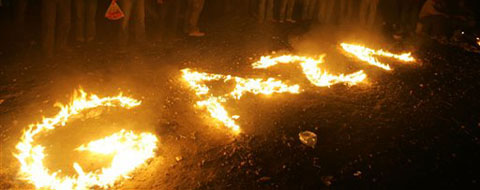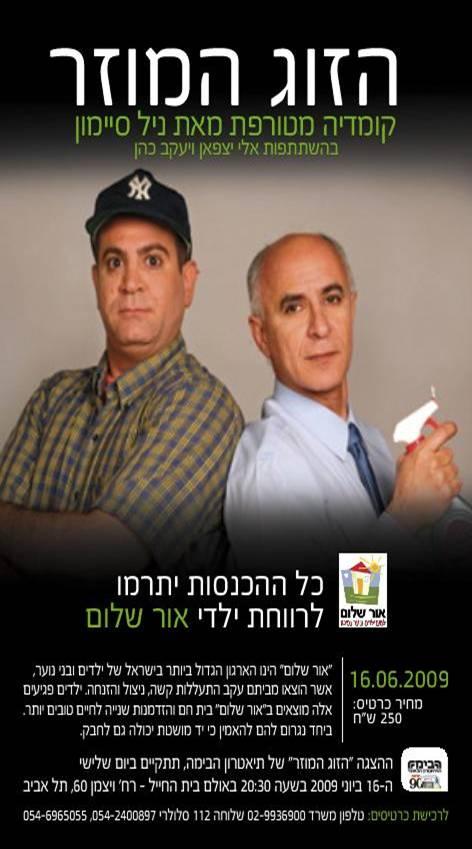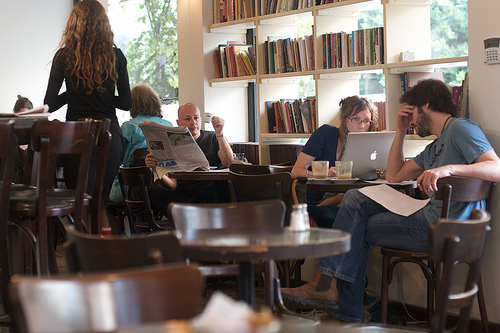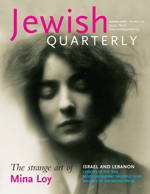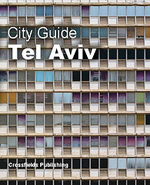The Tel Aviv refugee camp is clustered between the old central bus station and the spectacularly hideous new one, which was constructed in 1993. Both are located in the southern neighbourhood of Neve Sha’anan, connected by a pedestrian walkway called Neve Sha’anan Street. Once the area was known for its citrus groves and the elegant well house belonging to Alfred Roch, a wealthy Christian merchant from Jaffa (the Roch family is now based in Beirut).
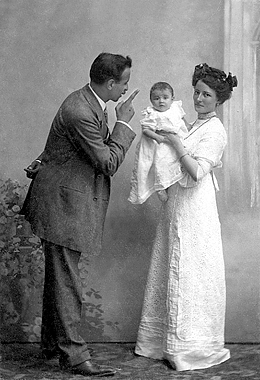
Alfred Roch with his wife and daughter, 1911.
During the 1930s, Neve Sha’anan became a typical Tel Aviv neighbourhood of low-rise, International-style apartment buildings, parks, schools and small shops. (Here is a clip of rare colour archival footage of Tel Aviv in the 1930s). Then came the middle class migration to the city’s northern quarters and suburbs, followed by a long period of decline. Today Neve Sha’anan is a seedy, rundown place that is inhabited mostly by refugees from Africa, foreign workers from southeast Asia, streetwalkers and junkies.
The old Roch house is a crumbling ruin, surrounded by ramshackle fruit-and-vegetable stands with corrugated tin roofs, or shops selling cheap electronic goods. Across the street is a pork butcher called, most imaginatively, Kingdom of Pork. Its name is listed in Russian, Romanian, Chinese, Thai and Tagalog. At night the street is filled with female, transvestite and transsexual prostitutes and rent boys - some from the occupied territories. Junkies squat in dimly lit alleys to shoot up. The beautiful International-style buildings that would be candidates for loving restoration in more salubrious parts of the city have instead been subdivided to accommodate as many rent-paying, desperate humans as possible. Their exterior walls have been uglified with Spackle and the windows covered in plastic shutters and rusty metal bars.
All in all, it’s an area that I tend to run through as quickly as possible – usually on my way to catch a sherut for one of my infrequent forays up to Jerusalem. During the six-month dry season, when there is no rain to wash the streets clean, the stench of urine becomes so powerful that I hold my breath at certain points, glaring at the oblivious men who barely bother to turn their backs before relieving themselves against a wall or a tree.
On Saturdays and holidays, though, the squalor recedes. While the rest of Tel Aviv sleeps, Neve Sha’anan Street becomes a bustling international bazaar. The newly arrived members of Tel Aviv’s melting pot pour onto the street to socialize, run errands and shop on their day off from labouring as caregivers to the geriatric, street cleaners, dish washers and construction workers. They rummage through piles of second-hand goods, ranging from cooking pots to jeans, that are laid out on the street to haggle over. Since they are effectively disenfranchised people from failed and/or war-torn and/or impoverished states, they have neither bank accounts nor credit cards. So they queue up at the places that sell SIM cards and cheap mobile phones, exchange currency or charge a high fee to send money abroad.
Last Saturday Melinda and I went to explore the other Tel Aviv and take some photos. A selection of Melinda’s gorgeous shots are below; she has posted the complete set on Facebook and more on her photo blog, which you really should check out – she’s incredibly talented. Meanwhile, I was experimenting with my recently acquired second-hand Canon 400D – my first SLR camera. So you’ll see some of my shots, too.
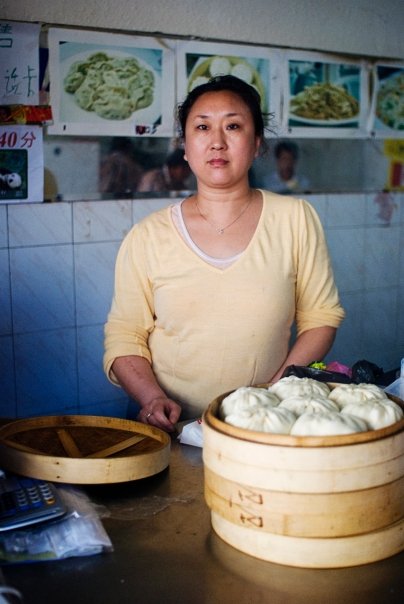
Melinda photographed this Chinese woman in her dumpling shop. This was the first time I found real Chinese dumplings in Israel – incredibly, the state of the Jews does not have any good Chinese restaurants. Perhaps because we do not need to worry about where we should go on Christmas Eve? Anyways, these dumplings are stuffed with chopped mutton and onions. There was congee, too. The TV in the shop broadcasts news and entertainment from China, via satellite. All the signs are in Chinese. The proprietess does not speak a word of Hebrew. Her husband, who lazes about smoking cigarettes and drinking green tea, knows how to say “5 shekels” and “10 shekels.”
We each bought a dumpling and sat down on the steps of a money changer to eat it and take some more photos. Next to us was a man who sold Chinese cabbage – four heads for NIS 10 (about $2.50). Melinda took his photo.

Meanwhile, I photographed this little African girl, holding her father’s hand.

And these people sorting through a pile of jeans for sale.

These women sold homemade eggrolls from the basket lined with orange plastic. Photo by Melinda.

This is Aziz, from Senegal. He was riding past on his bicycle when he saw us and stopped to chat. He said he works in a luxury hotel, and that life in Tel Aviv would be less difficult if only he weren’t so lonely. A girlfriend would help. “C’est trop difficile, etre seul,” he said, as I snapped his photo.

What about that woman? I asked.

Aziz said no, she wasn’t for him. I told him no, he wasn’t for me. So he cycled off, a bit miffed.
Suddenly, there was a commotion. Two men were shouting in a mixture of Arabic and Hebrew.

They were arguing over money. After awhile, I understood that the guy on the left was a junkie and the muscular guy on the right, in the striped T-shirt, was a dealer. The dealer made it clear that he didn’t deal for free; he shoved the junkie on the chest, hard, and stalked off angrily. The junkie stood silently for a moment; and then he began to cry in desperation. Melinda caught his heart-rending expression.

We decided to walk over to the nearby park, where men and women from all over the world sat in clusters on the grass, sharing snacks and conversation. Melinda photographed the kids playing football in the games court, while I leaned over and took a closeup of a drunk who’d fallen asleep on the grass.
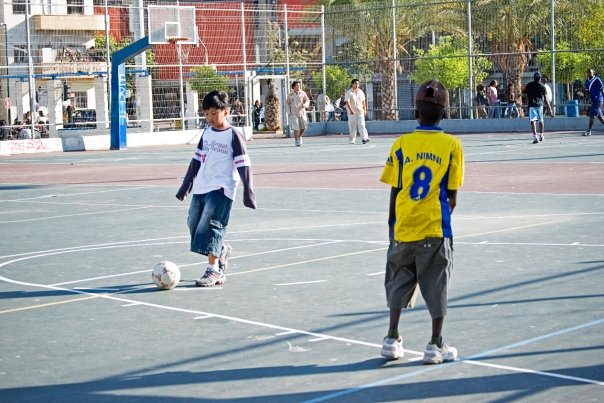
Kids playing football in south Tel Aviv, by Melinda.

Drunk asleep on the grass, by me.







